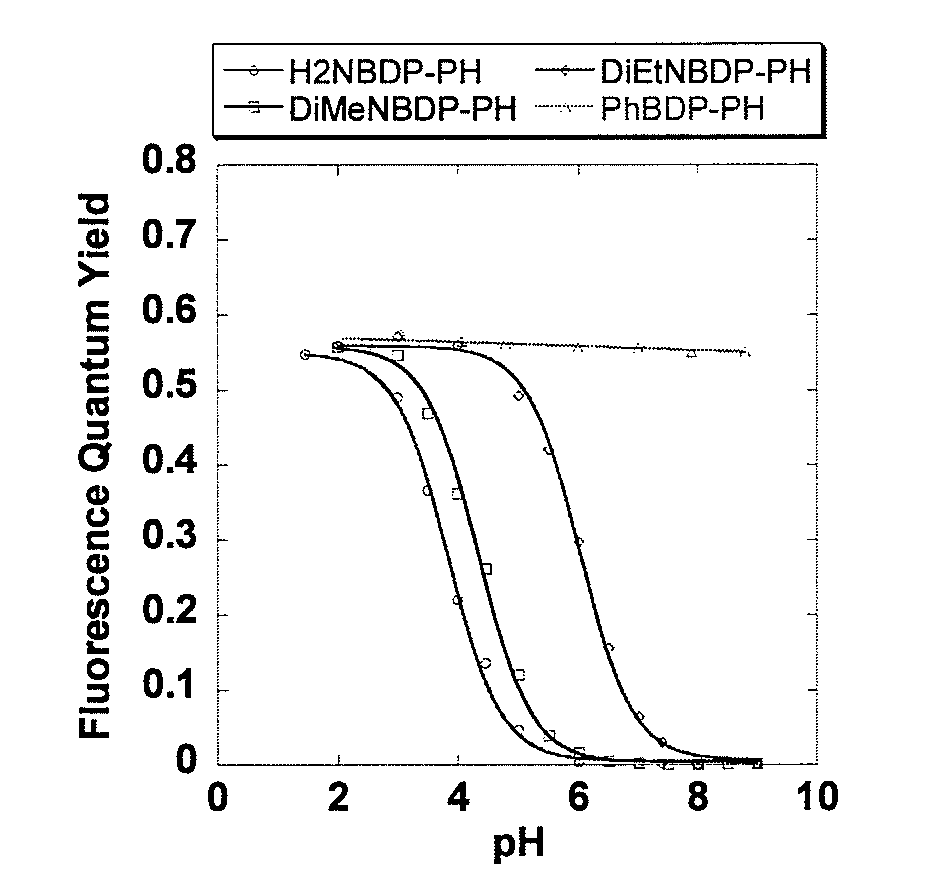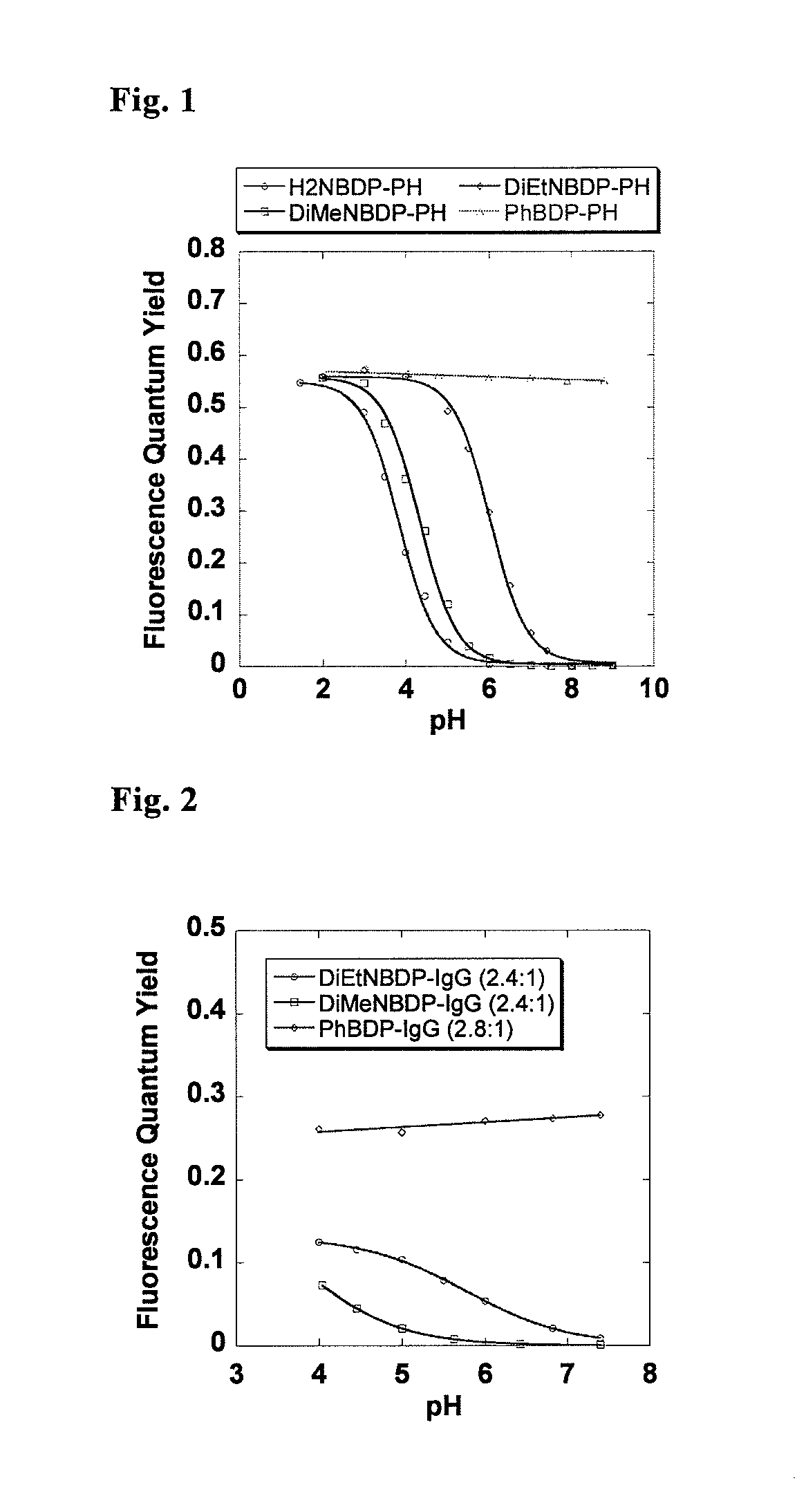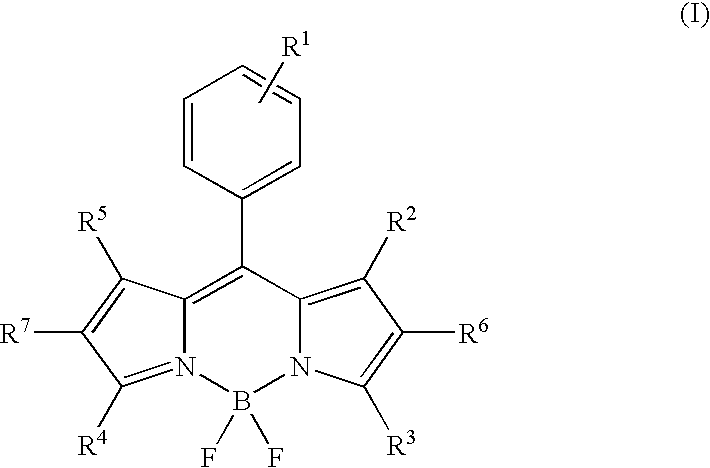pH-Sensitive Fluorescent Probe
a fluorescent probe and fluorescent probe technology, applied in the field of fluorescent probes, can solve the problems of acidic region fluorescence intensity decrease, fluorescent probe development,
- Summary
- Abstract
- Description
- Claims
- Application Information
AI Technical Summary
Benefits of technology
Problems solved by technology
Method used
Image
Examples
example 1
(1) Methyl 2,4-dimethyl-3-pyrrolepropionate (1)
[0024]Methyl 5-(benzoyloxy-carbonyl)-2,4-dimethyl-3-pyrrolepropionate (1.55 g, 4.91 mmol) was dissolved in acetone (150 mL) containing 10% palladium / carbon, and the mixture was stirred at room temperature for 12 hours under a hydrogen atmosphere. The reaction mixture was filtered, the solvent was evaporated under reduced pressure, then the residue was immediately dissolved in trifluoroacetic acid (TFA, 10 mL), and the mixture was stirred at room temperature for 10 minutes under an argon atmosphere. The reaction mixture was added with dichloromethane (30 mL), then washed successively with water and 1 mol / L aqueous sodium hydrogencarbonate, dried over anhydrous sodium sulfate, and evaporated under reduced pressure to obtain pale brown oil (1, 0.835 g, 94%).
[0025]1H NMR (300 MHz, CDCl3) δ 2.02 (s, 3H, NHCHCCH3), 2.16 (s, 3H, NHCCH3), 2.42-2.48 (m, 2H, COCH2), 2.69-2.74 (m, 2H, COCH2CH2), 3.66 (s, 3H, OCH3), 6.36 (s, 1H, NHCH), 7.64 (br s, ...
example 2
Optical Characteristics of pH-Sensitive Fluorescent Probe of the Present Invention and pH-Dependent Change Thereof
[0066]Optical characteristics of the compounds of the present invention, 3a (H2NBDP-PH), 3b (DiMeNBDP-PH), and 3c (DiEtNBDP-PH), and a compound not having an anilinic amino group as a pH detecting moiety, 3d (PhBDP-PH), as a control compound were measured. The results are shown in Table 1. It was found that the compounds 3a, 3b and 3c gave pH-dependency following the Henderson-Hasselbach equation, and they functioned as a pH-sensitive probe (FIG. 1). All the compounds were substantially non-fluorescent in a neutral to alkaline environment, and had a weakly acidic to moderately acidic pKa, and the deprotonated compounds were protonated in an acidic region to give fluorescence quantum yields increased 250 to 300 times.
TABLE 1λabs, maxλem, maxStokes' shiftεCompoundForm[nm][nm][nm][M−1cm−1]ΦflcpKad3aN-protonateda52053313721000.553.8N-nonprotonatedb51953617711000.0023bN-proto...
example 3
[0067]In order to impart a function for labeling a protein and the like to the compounds of the present invention, the compounds 4b and 4c were synthesized wherein one of the two carboxyl groups was replaced with succinimidyl (NHS) ester. The compound 4d not having an anilinic amino group was synthesized as a control compound.
[0068]IgG was labeled with 4b and 4c, as well as 4d as a control by the following method to obtain DiMeNBDP-IgG, DiEtNBDP-IgG, and PhBDP-IgG, respectively. As IgG, a marketed humanized monoclonal antibody therapeutic agent, Herceptin (registered trademark), was used. Herceptin was dissolved in 200 mmol / L sodium phosphate buffer (pH 8.37, NaPi buffer) to prepare a 1.0 mg / mL Herceptin / NaPi solution. The compound 4b, 4c or 4d was added to 1.0 mL of the 1.0 mg / mL Herceptin / NaPi solution. The mixture was left standing for 1 hour under light shielding, and labeled IgG was isolated by using PD 10 column (GE Healthcare) with PBS (pH 7.4, GIBCO) as elution solution. Flu...
PUM
| Property | Measurement | Unit |
|---|---|---|
| pH | aaaaa | aaaaa |
| pH | aaaaa | aaaaa |
| pH | aaaaa | aaaaa |
Abstract
Description
Claims
Application Information
 Login to View More
Login to View More - R&D
- Intellectual Property
- Life Sciences
- Materials
- Tech Scout
- Unparalleled Data Quality
- Higher Quality Content
- 60% Fewer Hallucinations
Browse by: Latest US Patents, China's latest patents, Technical Efficacy Thesaurus, Application Domain, Technology Topic, Popular Technical Reports.
© 2025 PatSnap. All rights reserved.Legal|Privacy policy|Modern Slavery Act Transparency Statement|Sitemap|About US| Contact US: help@patsnap.com



